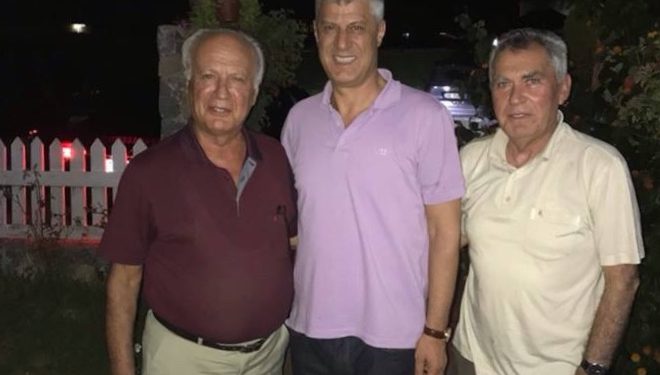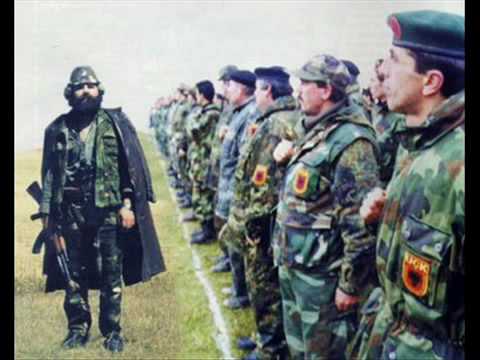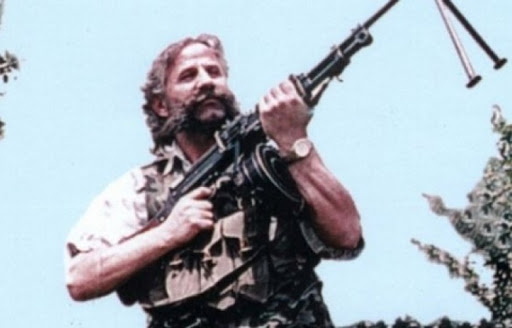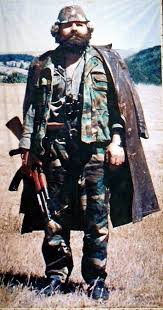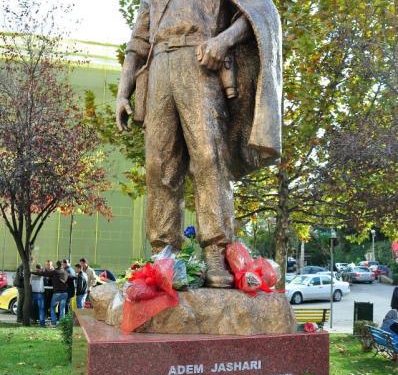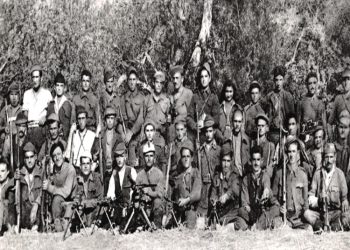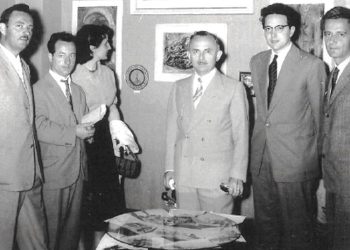Dashnor Kaloçi
Memorie.al/ In March 1998, in the village of Prekaz in Kosovo, during an armed attempt that lasted for three days, one of the main commanders and leaders of Slobodan Milosevic’s Serbian army was killed. of the Kosovo Liberation Army, Adem Jashari, together with 27 members of that family. From that day onwards, especially during the Kosovo war, Adem Jashari’s name and figure would become a real myth and legend, which would inspire many young Kosovars, wherever they were there, to seize weapons and line up in the ranks of the Kosovo Liberation Army. Many things have been said and written about the legend of Kosovo, Adem Jashari, or as it is already known by all, Baca Adem. Memorie.al is publishing an exclusive interview with the well-known publicist, journalist and writer, Bedri Islami, who has been one of the main leaders of the organization “People’s Movement of Kosovo”, which also politically led the Kosovo Liberation Army, where Adem Jashari, was one of its most prominent commanders and leaders. Given the fact that Mr. Islami, among other things, has been a close friend of the Jashari family, in his interview, which we are publishing in this article, he recounts many events and unfamiliar events from the life of Adem Jashari, as well as a long letter, which is published for the first time exclusively for Memorie.al.
Mr. Islami, 22 years ago, in March 1998, the name of Adem Jashari and his family would become known to all Albanians. This name, from that day onwards and in the imagination of Albanians everywhere, would rise to the myth and become one of the most legendary figures of the fighters of the Kosovo Liberation Army. You, Mr. Islami, join the ranks of his collaborators, but more, as far as we know, you are also known as a friend of the Jashari family. Based on this, can you first tell us something about how you got to know Adem Jashari?
Without the slightest doubt that the name of Adem Jashari is among the most well-known and respected in all Albanian-speaking areas and among his compatriots. It is one of the rare cases in human history, not only of our nation, when the name of man, in a very short time, as if from a legend, becomes the symbol of his people. Already, unlike ten years ago, when it was common to ask “who is Adem Jashari”, a myth, legend and truth has been raised about his name. How much do they have to do with each other, where is the beginning of one and the continuation of the other, at what boundary are they separated from each other, or all three together, not being, but a continuation of each other, constitute what today It could be called the “Nobel Prize” for freedom, as the French Foreign Minister Bernard Kushner put it in the first days after the war.
Why did the mythicization of Adem Jashari and the rise of his legend happen immediately after the fall? It was a coincidence, a call of the time, as the people needed a myth and a legend, it was a request or everything was true and it was starting to become clearly readable to everyone, to his followers, but also to the deniers of his?
Adem Jashari is one of the main founders of the Kosovo Liberation Army and its first commander-in-chief. On the day he was killed there were more than twenty years of illegal activity, he had been convicted three times in absentia by the Serbian government, and all three times 20 years earlier, he had been involved in illegal war structures for more than 10 years. Since March 8, 1998, the name of Adem Jashari, his father, his uncle Shaban, his brother, Hamza, his uncle Osman, and all those who fought in that early March, of the towers that were burned, of the 57 lives that were given, of the rifles that were raised, of the war until sublimity, became the beginning of the symbol of the people who belonged to it. No decree was needed for this and as such no one could issue it, no decision was taken, no special meeting was held, everything flowed quite naturally, very human, sublime I would say, to the point where the border between myth, legend, and truth is never clearly defined, especially in the early days.
Was there another cause, as great and sublime as their downfall, which brought about the immediate mythology of Adem Jashari?
Of course yes. In the first days, after his fall and the comrades of the Kosovo Liberation Army, it was natural for the figurative, emotional, tangible, painful, more accessible side, the war, the resistance and the sacrifice, to be more evident. But Adem Jashari’s name was known. In March 1998, he was already the name of a warrior man who had broken Serbian police forces twice in a row. Also, the Kosovo Liberation Army was associated with his name. It should not be forgotten that three months ago, on November 28, 1997, the Kosovo Liberation Army made its first public appearance. On the other hand, it is a beautiful coincidence that Adem Jashari was born on November 28th.
But these are not enough to make a myth, they can very well make an example, a leader of the day, a name to follow, they can make a song or many songs, but they cannot make the myth Man , can not lay the foundation of the legend, which in this case, is nothing but the truth ?!
It took Adem Jashari no more than 48 hours to get the name of the warrior man in the myth. From the day he decided to resolve the Kosovo issue through the rifle until the day of its fall, it was more than two decades, but even that would not be enough to explain the extraordinary myth of the Jasharis. From the day when the first foundations of the Jashari tribe were laid in Prekaz and until the day when their towers would be burned for the last time, three hundred years would have passed, but even this autochthony does not have it all in itself.
On what day or on what demonstration was the name Adem Jashari made public for the first time?
This happened on March 9, 1998, two days after the end of the war in Prekaz, in the city of Stuttgart. The People’s Movement of Kosovo would organize a large demonstration against the violence and Serbian occupation of Kosovo. It was the manifestation and at the same time the first big demonstration that took place. Together with Professor Hasan Ukhaxhaj, we were invited as leaders of the movement to speak at this event. There were more than twenty thousand people in the big square. It occurred to me to have the chance word. It was not immediately clear what had happened in Prekaz, the news was unclear to the end, nor was anything clear in the Jashari family living in Munich. It was in this square that, for the first time, less than 48 hours after their murder, Adem Jashari’s name roared. I have seen people calling his name wholeheartedly, waving the national flag, as if his soul was already on the sides of the flag. It was a new, very special call, from no one oriented, out of the depths of the soul, although there were still many, many who ask, “Who is Adem Jashari?”
I’m going back to the question I asked you before: was it a coincidence, a request of the time, or was everything natural, human and exactly deserved the mythicization of the figure of Adem Jashari?
We are used to seeing Adem Jashari in various photographs, always with a gun in his hand, with the war cape thrown over his arms, with his beard shed like the Sharr Mountains waterfalls, with his unique look. His eyes speak more than hundreds of statements, we are used to imagining a man who has just fought, organized actions, stood up, defeated enemies, warmed people’s hearts. That’s how we’re used to it, and all of that, being true, is also incomplete. Adem Jashari is not only the picture we know, only the essence of what we believe, it is not only the shelter from which, necessarily all those who wanted to fight have gone, he is much more than that. Even many years after his fall, many people who held leadership positions in the war structures, when they want to prove a position or have support, naturally turn to Adem Jashari or the fact that they have been in touch with him, that they have stayed to the Jasharis, that they had contacts or that they helped them. After all, this is the force that gives rise to the name of the Jasharis, especially Adem, Baba Shaban and Hamza, and we must accept it as such. Jasharis, whether they like it or not, will never be able to avoid the support that others seek in their name.
What made and still makes Adem Jashari very special in the history of our nation? What is the flow through which his name has gone and continues to go? Was he just a warrior, a man with a rifle thrown over his arms, iron and cold, speechless and serious, or was there much more than that?
Personally, I mean physically, I have never met Adem Jashari. I do not join the ranks of people who have had such a fate in their lives. I first heard his name from Fehmi Lladrovci, another prominent figure in the war in Kosovo, who was killed along with his wife, Xheva, on September 22, 1998. Fehmiu had an extraordinary respect for him and I think that Adem Jashari was the only man before whom Fehmi Lladrovci bowed. Then I would learn that even Adem Jashari, when he was asked to have a separation with Fehmiu, meant that “only death separates me from Fehmi Lladrovci”. This was my first acquaintance with him, through figures who were close to Adem Jashari, but, frankly, I did not think that we were talking about the man who would soon, very soon become a mythical figure of Albanians. It was the time when he had just been sentenced to twenty years in absentia, in the well-known trial against the Drenica Group. Then I saw his picture and I was impressed by his eyes, who, whoever looks at them with remarks, feel that they have extraordinary similarities with the eagle. But I had another double fate: I knew closely, as their friend, the extraordinary family of the Jasharis, who have their unique share in the war that took place in Kosovo. I can say with conviction that, if it had not been for their open support and engagement in war structures, many things would not have gone as things would have flowed further. In their family, many times, they have met me to see the various family recordings, quite common, to see Adem and Hamza between their families, to follow the course of life they have made, the daily chores, to listen how they conceived life and how they thought about the future of Kosovo, speaking quite naturally, I saw them play with the children on an ordinary day, how they behaved with their parents, that special act when they took them in their arms the old mother’s hand and they caressed her gently, the noiseless and noisy entrance into the guest room, until an ordinary day when they were dealing with daily chores, such as pruning trees or tearing down trees in the backyard. From the Jashari family, I talked to my friends who were in Drenica. My other fate is related to the fact that during the war years I was elected the main leader of the “People’s Movement of Kosovo”, an organization to which I had met Adem Jashari, since the mid-80s. In her archive were and then I took many tapes, in which were recorded the messages of Adem Jashari, his thoughts, his attitude to people, various events and positions, I heard his vision, which, yes the same weight and the same strength as war. There were letters, which are still preserved today as extraordinary treasures, and through them, you can clearly see that behind him is not only the man of war, but also of visionary thought; he is not only a warrior, but also a leader; it is not only the present, but also the experience that had gone; it is not only Drenica, but also Kosovo, it is not only Kosovo, but also the most extreme borders of London Albania. I have never seen Adem Jashari simply as a fighter, as an ordinary outcast of Kosovo, but much more than that. The portrayal of Adem Jashari simply as a fighter, leader or even something more, has never been accurate. Because it has been incomplete. That is the point. Because there was only one side of his show, the most visible, the most imaginable, the most accessible. The one that is even easier to talk about, but that is not always the whole truth. We must get used to seeing Adem Jashari beyond this imagination, we must get used to seeing him in those dimensions that are the truth of his life and political thought, visionary perception and their manifestation at the turn of the last century.
What were some of the most fundamental moments of Adem Jashari’s political thought and vision?
After major arrests in Kosovo, the then government proposed to him, like many others, to leave Kosovo. He refused. Adem Jashari had his mature political opinion and this is the first cornerstone of any resistance: for our country we must fight in our country. Neither the bread of the stranger, nor the warmth of the stranger, nor the word of the stranger do us good. So he could stay, let’s say in Germany, but it’s one of the first things he doesn’t think of. The clear political vision that the war should start on its own and take place in Kosovo would be among the decisive ones in the politics of the last century. Adem Jashari, along with other major figures, such as Zahir Pajaziti, would have the extraordinary, unrepeatable merit, I would say, that after clearly defining their vision, they also became the embodiment of this vision. In the Christian holy book, the Bible, there is also the famous saying of Jesus Christ: “You cannot be a prophet in your homeland.” The example of Adem Jashari proved that it could have happened differently. He could have been a prophet even where you were born. This would happen if you never left your country, if you did not lose those special ties that hold you back. Second, Adem Jashari would create, first in his memory, and then in the political configuration of war structures, the exact idea that war could be won, if the mother country, Albania, were the second refuge of the war. . To make this vision clear within himself, he recreates the myth of Çerçiz Topulli and, together with his brother, Hamza, the myth of Mihal Grameno. He could raise another myth within himself. There were many, but he searched for it to the point where he thinks it could be the most extreme example, in Gjirokastra, and where it is also the most significant: a Tosk, a fighter killed by the Slavs on the shores of Lake Shkodra. In the days and nights of the famous war of March 5, 6 and 7, Adem Jashari would once again return to his myth: all the while he would sing the famous song of Çerçiz Topulli. He would repeat it over and over again, turning it into a call and force, and then, shortly after the end of the war, Besarta, the only granddaughter of the surviving tribe, would say, “As soon as I heard Adem singing, I didn’t I was scared. ”. Adem Jashari’s vision that the war should go through the whole nation would be more than accurate and vital. He, in many cases, would be among the most determining factors, and the silent man, Adem Jashari, had known and preceded this. Adem Jashari’s political vision, while wrapped in the configuration of the weapon, has in its depth the clear opinion that the war was necessary, as there would be no other way and, secondly, this war should not be fought, just like that, kaçakçe, how it had happened not infrequently in the history of our nation. He demanded much more than that, and in order to do so he had the ability to wait, to walk in the right direction, not to rush, and not to create a closed circle around himself. More than anything it would be a political war that required a political direction. In the early 1989s and beyond, Adem Jashari would be one of the members of the illegal structures that would demand the establishment of the Albanian army. But not only that. Drenica’s group, which featured the role and figure of Adem Jashari, would clearly say: “We are ready to do one more action a week, but someone has to take ownership of our actions. “Not only to support them, but also to have political representation, political support.” This would be the first time in many years. Until then, spontaneous or organized movements of the Albanian resistance in Kosovo had not had this essential element, now illegal political forces demanded this, perhaps even given the experiences so far. Adem Jashari would be one of the first to demand this, as a major force to create armed resistance and fight to victory.
Was it possible for the war to start earlier and for Adem Jashari to take over the leading role at that time?
Of course yes. It is a well-known fact that the first siege of the Jashari towers took place on December 30, 1991. The three boys were at home, Rifati, Hamza and Ademi, their father, Baca Shaban, and the other members. The siege began in the late evening and, as members of the Jashari family would later testify, was expected. It was the peak of winter, the extreme cold, everything was covered in snow. The three men of the Jashari family, after heavy clashes, will break through the siege and go in different directions, from where they once again ignited the fire of war. Police took 27 members of the Jashari family hostage, while all the men, from Fitimi and above, ie those over 13 years old, were taken out with their hands tied, in the snow, in front of the tank. The police also took out the Jashari mother as a shield in front of them, wanting to enter the house, always with the thought that Ademi was inside. Meanwhile, the Drenica Group had gathered. In the hours that followed, armed men from Prekazi, from all over Drenica, but also beyond, began to come to the aid of the Jasharis. The mountain in front of the towers was full of people. Each had a gun with them. There they gathered to judge and told the Jasharis: “Take command and lead the war.”
Mr. Islami, has it been possible for the war to start earlier and its leadership to be taken over by Adem Jashari?
If Adem Jashari had had the narrow concept of war, that is, if he had thought that “haj, we are starting.”, All those people who had surrounded the mountain would be a great drive to do so. An ordinary, revolted man, ready to fight, would probably have thought it reasonable to “start over.” Ultimately it would have been justifiable. All the more so this would have been justifiable in moments of personal pain, when you see that all family members are hostage to the invader, when the boys are tied up and their fate is unknown. But that would be natural for an ordinary person, not for people who bring back the history and life of a nation. Adem Jashari’s visionary vision of first and foremost building up the structures of war, relying not only on one man, but on one family or one tribe, proved that he had been right and correct. The fact that around him gathered, in one way or another, from afar or up close, all those who would be at the same time part and implementers of the Kosovo Liberation Army, inevitably leads to another opinion: who were they to him? who Adem Jashari had forgiven his great faith and had sworn allegiance to would go to work to the end?
In the history of the Kosovo Liberation Army, is there a known date on which important decisions were made?
There is such a date. It is April 5, 1993, when the famous Meeting at the Jashari Tower takes place. I think it’s one of the most important dates of the war. Even in this meeting, Adem Jashari does not put himself above others, because he did not even intend to do so. A few words, as always, were uttered by two great troubles: the progress of the rising army, its naming, and, most importantly, its return to its political responsibility for stock action. The April 5 meeting in Prekaz was one of the most important for the Kosovo Liberation Army. Some of the well-known names of the war would be part of it, including Hashim Thaçi, Fadil Kodra, Hamit Jashari, Sahit Jashari, Besim Rama, Rafet Rama, Jakup Nura, Ilmi Zeka, Jakup Krasniqi, Sami Lushtaku and others. . The fact that they gathered in the towers of the Jasharis, although under constant surveillance and could be attacked, testifies to two things: the security it provided and the leading role of Adem Jashari.
How is the role and leadership function of Adem Jashari known? Through which channels has such a thing passed?
Although he never demanded such a thing, that is, to be the leader, all this, within Kosovo, became quite natural, as something common and understandable. The gates of those towers would include: Rexhep Selimi, Mujë Krasniqi, Sulejman Selimi, Nait Hasani, Ramiz Lladrovci, Jakup Krasniqi, Iliaz Kodra, Nuredin Lushtaku, Abedin Rexha, Kadri Veseli Ahmet Ahmet Haxhia and Ramadan had previously made this road. avdiu. Then Adrian Krasniqi and Daut Haredinaj would go to her. Related to it: Xhavit Haliti, Ali Ahmeti, Fehmi Lladrovci. This means that his collaborators were almost all known names of the war. This was not a coincidence and it would not be accidental that in the most difficult days it would be necessary to rely on the name of Adem Jashari. Quite logically, it became the center of the war, and the subsequent course of events proved the veracity of Shaban Jashari’s statement that “I am giving you the trust, if it dances in Prekaz, it will dance all over Kosovo.”
And when did the battle start in Prekaz?
The Jashari tribe has experienced three sieges by Serbian police and paramilitary forces. They were first surrounded on December 30, 1991, and from that day on, Adem Jashari’s illegality began. They were besieged for the second time on January 22, 1998, and two months later, in early March, where the already well-known battle in history took place. Arkan’s paramilitary forces and himself were also involved in the second and third sieges. Of course the third siege has been even more multiple. I can say that it has been several times, and despite all the efforts that have been made to help, it has still been difficult, if not impossible. The war lasted more than two days and two nights. They all fought, from the old man of the house, Adam’s uncle, who had been friends that night, to the children over 12 years old. One of the children, Fitimi, was found dead with a machine gun in his hand, in the backyard. 26 people hanged in the three towers of Jashari, while 57 people from his entire tribe. As I told you, all the time Ademi sang the song of Çerçiz Topulli. He was killed last and after his fall, for several hours no one approached the burnt towers. But after the war in Prekaz, it is true that it jumped all over Kosovo. At that time I was in charge of the organization, which politically led the Kosovo Liberation Army and I know very well how their downfall turned into a miracle, which, to be honest, we never thought would happen in those dimensions.
Historical evidence through a letter sent by Drenica
This letter, sent by Adem Jashari and written by his brother, Hamza, as well as signed by a group of Drenica fighters, is one of the messages of the war. Of course it was not written with the thought that it would ever be published; it is a letter between comrades-in-arms, talking about the realization of an action and other problems. But throughout each line, you can clearly see what was to come. Written simply, like everything that is magnificently beautiful, without big words and without boasting, it carries within itself the historical evidence, not just of a battle. This letter was written at the end of 1997, more precisely in December of this year. Initially, it was faxed from outside Kosovo, according to data from a fax at Skopje Airport, and then came the original, after a few days, through illegal channels. The letter is kept today in the archive of the People’s Movement of Kosovo, where it was addressed, while a copy of it is kept in Kosovo. We are publishing this letter almost in full.
Dear friends and brothers!
Some information about the event in the village of Vojnik, which took place on November 25, 1997 between our forces and the secret police of the Serbian occupier. The event begins with the announcement of a civilian vehicle type “Niva” with four civilians, which made suspicious movements in the village, from the neighborhood to the neighborhood. We noticed him and escorted him until he came to the Binakaj neighborhood and right next to the house where our activity is located. According to the friend’s confession, he tried to identify them, but they tried to betray him, appearing to one of them that “we are Albanians” and as soon as he finished speaking, one of them fired a revolver several times at our activist. . His skill saved him from the bullets, and at high speed he returned the machine gun and shot the vehicle, and it is known that he shot some of what was happening inside. The suspects left the scene at high speed, leaving broken glass marks and blood marks. This happened around 14.00. After the suspects leave, he returns home and joins three other friends, who were ready to help, but the danger was thought to have passed. They decided not to leave the village unless there was a possible police intervention. So it happened. After two hours, that is, around 16.00, two armored vehicles enter the village, accompanied by a “NIV.” And attack the Binakaj neighborhood. These, our comrades, occupy positions on the nearby mountain and on the nearby fences. As soon as the punitive expeditions of the special forces arrive, they descend from the armor and start firing in different directions, to spread panic. But at that time, our forces, composed, as we said above, of four people, opened fire and turned the conflict between them and the Serbian punitive expedition. Unequal in number and technique, the attraction is made in the direction of the forest. Serbian special forces fired incessantly and began to approach, forcing us to use the bombs, although few. Then, with the use of bombs, the Serbs withdrew to the armored vehicles and the war was fought only by the armored vehicles. This lasted until about 6 pm, but they could not shoot us from the position we took in the forest. This prompted them to leave the neighborhood and the village at high speed. We did not have any casualties or injuries: the enemy had blood marks at the scene, especially when bombs were used. Regarding the subsequent organization and information of the members, the event takes place as follows: In our organization there are also field observers. One of them noticed the armored cars heading towards Klina or Turiqevc, until we had information about the case we talked about above. Some of our points are announced and they announce the members, but only to be ready, as soon as we receive the news of what is happening on the ground, to be ready to help. The night took its toll and it was too late to find out that it was the village of Vojnik where the police forces went. Although we rushed to Vojnik, the police withdrawal prevented us from confronting each other that evening. We gathered and found that there were no casualties from our forces. We decided to observe the terrain, all the way to the scene. We sent observers, and then others, and decided, after obtaining the consent of the comrade, in direct events that: if the police undertake any punitive operation, we will resist. It was decided to occupy the most strategic points on the roads leading to the endangered region before the morning, given that the forces could intervene from Mitrovica, Peja, but also from Pristina. The groups that will be ambushed were assigned, as well as the observers for notification. Everything in and around Drenica was under control. Our wish was and we prayed that this would be the case in the very place where the confrontation took place. So there we predicted that we would reap victory. We had the opportunity to “cut” them in another place before, but right there, wherever we wanted, they came to us. We were some groups, in some ambushes. The column was long. We had the news from the observers that they were also accompanied by helicopters. We waited for them until they entered among all the groups of 3-4 to 5 people in a group, where the total number of us was 23 (understood from the village of Lludeviq to the place called “pop crosses”). The others were in other places, so as not to describe them all now. The column entered where we wanted. First we attacked with minesweepers, and then some with bombs and some with different firearms, such as automatic, snipers and machine guns. The confrontation began around 10 a.m. where it lasted until about 1 p.m. The operation was very difficult, fierce, uninterrupted warfare, we spent a lot of ammunition, especially on helicopters. The disposition in our forces was at the level, although some were in the front. Apart from the ammunition expenditure, there were no casualties or injuries from our forces. Which is more important even the villagers of these parts responded and the mountains were filled with ready fighters, where during the retreat the police were attacked from all sides, and where the police panicked and shot, in civilian buildings, schools and mosques. After we pushed the Serbian special forces to withdraw, we went to the scene where the enemy forces were. They had left a lot of evidence to show that they had suffered losses and that they had been panicked. We found various ammunition of large caliber up to the revolvers, bloody bulletproof vests, helmets, various cartridges, gas masks, tear gas cartridges and many more. The entire road from the village of Lludeviq to the place “Crosses of Pop” was covered with shells. The enemy’s dams, as we have seen, are a dilapidated armored car, a broken one, a destroyed machine gun, one of the burnt “pizgauers” and some partially damaged armor. We suspect that the helicopter was hit, that it left very quickly and did not appear again, leaving its forces alone, half an hour before they retreated. We have high demands for membership, but we lack weapons. Very little has worked in this direction. Therefore, the comrades who operate in this area of Drenica, ask us to represent one of our former comrades who has been outside for some time now, under his conspiratorial name “VESHI”. At the end of this story, we cordially greet you from Drenica. Glory to the fallen for freedom./Memorie.al






